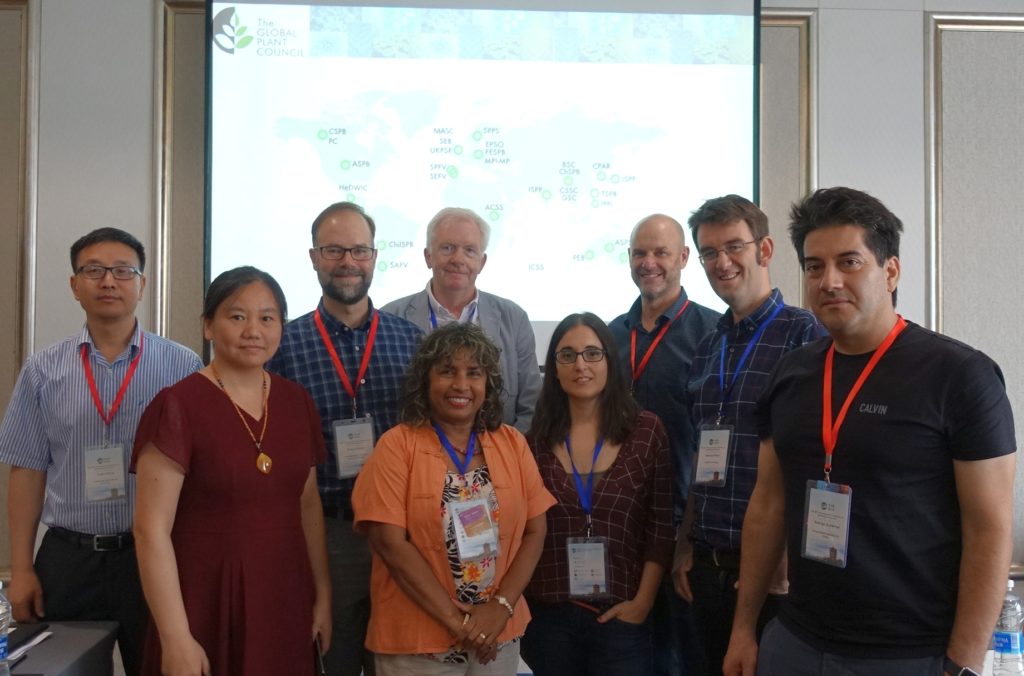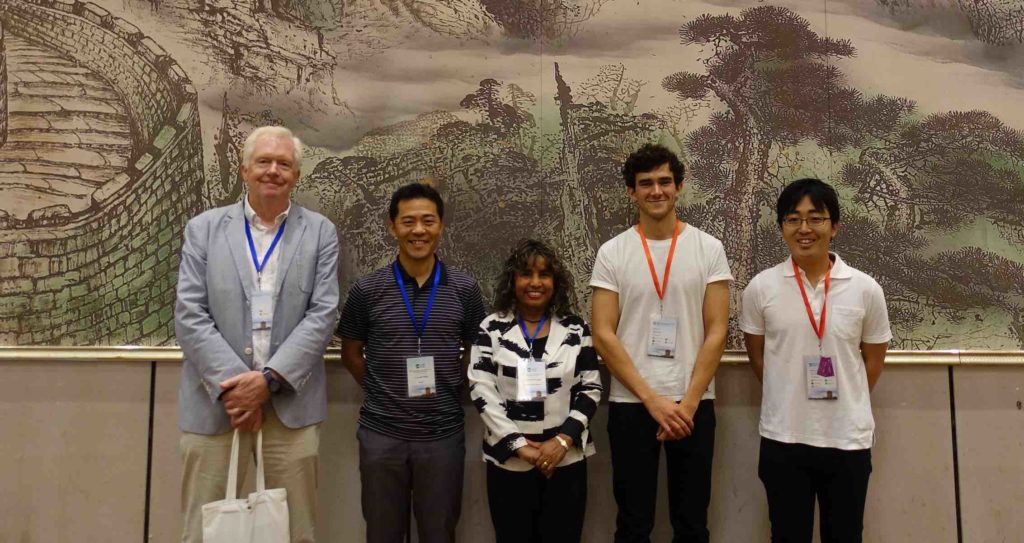






GPC annual meeting group picture. From left to right: Xuelu Wang (ICAR2019 organizer); Weihua Tang (China Society Plant Biology); Blake Meyers (Danforth Center); Deena Errampalli (GPC Board of Directors Treasurer, President, Plant Canada); Bill Davies (GPC Past-President, UK Plant Sciences Federation); Isabel Mendoza (GPC communications officer); Barry Pogson (GPC chair, Australian Society of Plant Scientists); Geraint Parry (SEB, MASC) and Rodrigo Gutierrez (Chilean Society of Plant Biology)
One of the Global Plant Council’s (GPC) principal objectives is to reach the global plant science audience. And to pursue this aim, the GPC annual meeting is held every year in parallel to a big plant science conference.
In accordance with this practice, the GPC took its annual meeting this June to the 30th International Conference on Arabidopsis Research (ICAR2019). This international conference was held on June 16-21, 2019 in Wuhan, China and attended by over 1,000 plant scientists from around the world.
GPC also took an active part in the conference itself hosting two of the offered workshops. Understandably, many members of GPC board were there, either as invited speakers (Barry Pogson, GPC Chair); or as part of the workshops organizing team (Bill Davies, GPC past-president; Deena Errampalli, GPC treasurer; Yosuke Saijo (Board Member) and Isabel Mendoza (GPC communications officer).
The first workshop “Role of the microbiome in sustainable agriculture” was held on the 18th June. Led by Deena Errampalli and Yosuke Saijo and with the participation from Bill Davies, Ruben Garrido-Oter and Kei Hiruma. Over 40 people attended the workshop, which provided participants with up-to-date knowledge on the role of the microbiome in Arabidopsis and its application on sustainable agriculture. Practical cases such as the Canadian ginseng were also introduced.

On the 19th June, the GPC team held the second of these workshops “Communicating your science to the broader community” addressed especially for early career researchers. Over 45 people attended. This meeting was led by Isabel Mendoza with the cooperation of Mary Williams (@PlantTeaching) and Geraint Parry (@GARNetweets). The meeting provided participants with clues on how to increase the impact of their own research, helping them understand the rules of science communication and tricks on how to profit from the more commonly used online channels.
This was the first dissemination activity of the recently established Early Career Researcher International (ECRi) network, an initiative that aims to help the ECRs in developing their careers. A dedicated post on the issues discussed at the workshop is on development. Stay tuned!

By W.J Davies and Jianbo Shen
Lancaster Environment centre, Lancaster University, Lancaster, LA1 4YQ. The UK and National Academy of Agriculture Green Development, Centre for Resources, Environment, and Food Security, China Agricultural University, Beijing, 100193, China.
Fourth post of our “Global Collaboration” series
In early 2019, the EAT-Lancet Commission on Healthy Diets from Sustainable Food Systems produced its first report. The Commission report addressed our need to effectively ‘feed a growing global population with a healthy diet while also defining the kinds of sustainable food systems that will minimise damage to our planet’. While it is clear that our current food and farming practices threaten both human and planetary health, the Commission concludes ‘that Global Food Systems can provide win-win diets to everyone by 2050 and beyond. However, this will require nothing less than a Great Food Transformation’
Despite a growing realisation of the magnitude of the challenges that are a part of such transformations, in most societies, progress is slow. Plants Science has much to contribute to enable better diet quality, increase crop productivity, enhance environmental sustainability and create new products and manufacturing processes (see example) but cannot alone bring about all of the required transformations.
For the required changes in government policies and in human behaviour, we must be able to convince people of both the nature and magnitude of the growing threats to human and planetary health as well convince all sectors of society to adopt as targets for the future, such as the UN Sustainability Goals. A range of actions is required from both organisations and individuals working at all scales.
Effective knowledge exchange (KE) mechanisms between scientists and food producers is recognised as being key to delivery of many changes in practice required within the framework defined above. Change is perhaps more easily achieved at the industrial farming scale where new genotypes and changes to farming systems are commonly produced and accepted. A wide range of publications means that practitioners can regularly see that these innovations can have significant effects on food availability and quality. However, most food in the world is still produced by smallholders and effective examples at scale of KE between science and this community are less common.
In China, there is an urgent need to address issues of food access and availability, food quality and safety and the environmental impact of agriculture in a society where diets are changing as the economy grows. As part of China’s successful green revolution over the last 50 years, enormous increases in food production have been achieved largely as a result of advances in both plant breeding and agronomy Very large increases in the usage of fertiliser, agrochemicals and particularly of water have increased productivity but all of this has been very damaging to the environment in many regions. Commonly, both quality and safety of food are significant issues in China due to both contamination with agrochemicals and as a result of food fraud.
Nevertheless some positive changes are underway in the food system with increased consumption of fruit and organic vegetables in Chinese diets but even here extra water use is often required and this is certainly the case also as a result of increasing consumption of meat in the diets of increasing numbers of people. Excess water consumption has reduced water tables in many regions of China (and other important food production regions). Reduction to dangerously low levels is leading to desertification in some regions with real threats to capacity for sustained production by farmers in these and other regions. Excess fertiliser use has resulted in many high profile pollution problems in surface waters which are valuable both for agriculture and for cultural tourism.

The introduction by scientists at China Agriculture University of ‘Science and Technology Backyards’ (STBs) is one very innovative approach to helping smallholders in China transform agriculture to respond to the challenge of greater ‘Ecological Civilization’, as set out in recent years by the Chinese Government. Using such an approach to exploit recent advances in plant and crop science is very much in tune with the agenda of EAT-Lancet Commission. In increasing numbers of communities across China, agricultural scientists living in villages among farmers to achieve yield and economic gains sustainably. The aims of this knowledge exchange programme are to advance participatory innovation and technology transfer and garner public and private support for these innovations. The approach has identified multifaceted yield-limiting factors involving agronomic, infrastructural, and socioeconomic conditions and interventions at the personal and community level are transforming peoples’ lives.
Due to past experiences of famine and political instability, China’s government has made grain production and food security a top priority for the nation. By the 2000s, after years of food shortage, China finally produced enough food annually to feed its enormous population. Now, China has set a new target of green growth in future grain production. This target involves high efficiency in resource use with reduced environmental risk. Novel developments in agronomy enable maintenance of a relatively high grain yield on a regional scale. To help deliver on these targets, China is also developing strong policy incentives for environmental protection and green growth in grain production. Going forward, it is planned that Chinese agriculture will continue to put into practice a vision of innovative, coordinated rural revitalization and green development. The science and technology backyard (STB) model could provide an effective approach to realize the green development of agriculture, as it aims to close yield gaps in China by empowering smallholder farmers through integrating efforts of researchers, farmers, the government, and agro-enterprises.
Success at scale in improving sustainable resource use and increasing grain production in China will enhance the country’s food security while decreasing poverty and the environmental footprint of food production, thereby contributing to the global goal of sustainable development. To meet new demands of Chinese agriculture in a new era, as well as for promoting further implementation of United Nations (UN) Sustainable Development Goals (SDGs), the National Academy of Agriculture Green Development and the International School of Agriculture Green Development were launched by China Agricultural University in July, 2018. A national strategy of Agricultural Green Development, issued by the central Chinese Government is likely to provide valuable understanding and new production practices, particularly for smallholders in other developing countries that are already facing or will soon face dietary and environmental challenges similar to those currently faced by China.